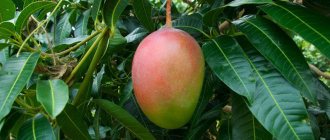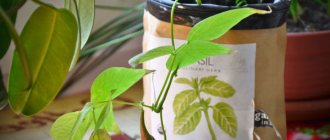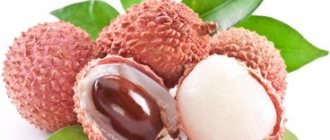Updated: 07/01/2021 11:35:27
Lychee is a fruit tree from the Salindaceae family. In the literature, the plant is called Chinese lychee or lychee. Its homeland is southeast China, Guangdong and Fujian provinces. In its natural environment, the crop grows and bears fruit in a subtropical climate with dry and relatively cool winters. Closer to the equator, where the humidity level is higher, the plant no longer bears fruit. In temperate latitudes, lychee is grown in greenhouses, where it begins to bear fruit after reaching the age of 10 years. Thanks to its shade tolerance in indoor conditions, when creating an optimal microclimate, lychee becomes an exotic “decoration” of the interior.
External characteristics of the lychee tree
Lychee is an evergreen tree native to the tropics, where it reaches a height of ten to thirty-five meters. Having planted it at home, it is rarely possible to grow a tree up to two meters; usually it does not grow to that size.
Having a second name - Chinese plum, since it was first cultivated in China, lychee belongs to the Sapindaceae family. And today this plant from China has become widespread in America, Africa, Japan and is highly valued there for its tasty and healthy fruits.
The tree has a dense crown located on a smooth trunk with gray bark and pointed foliage. The first fruits can be obtained from a tree from the age of four in the form of small oval red fruits with a brown seed in white pulp. The fruit is covered with a pimply peel, which is easily removed from the jelly-like pulp with a pleasant aroma.
The fruit takes a long time to mature and becomes edible only four months after flowering. The lychee tree can only grow in the tropics and will not tolerate low winter temperatures, so in other climatic conditions it can only be grown in a greenhouse or at home, in a room.
What is lychee fruit, what does it look like, where is its homeland: description
The fruit called “lychee” is very unusual and is considered exotic. Some call it a fruit, others say that lychee is a berry. Be that as it may, lychee not only has a pleasant and rich taste, but also great benefits. The benefit of the fruit is that it has a unique biochemical composition - a lot of vitamins and microelements.
It’s worth noting right away that lychee is not a large fruit, its diameter is approximately 3-4 cm . The weight of one berry does not exceed 15-20 grams . The peculiarity of the exotic fruit is its dense and slightly prickly peel, which covers the juicy and jelly-like pulp.
The color of the pulp is milky. Hidden inside the pulp is a large dark brown seed. The taste of lychee is very pleasant. The ripe fruit has a sweet tint with a slight sourness. If you try to find a comparison with other fruits, the taste of the pulp is somewhat reminiscent of cherries and pineapples. The aroma of the pulp is very fresh and sweet.
Lychee is a fruit common in Asia: China, Japan, India, Thailand . In these countries, lychee is often called the “eye of the dragon” for its visual similarity to an eye: a white apple and a black apple. For its beneficial and nutritional qualities, lychee has gained popularity in folk medicine. Many even consider it an aphrodisiac due to its rich zinc content, and therefore lychee is a mandatory treat on the tables of newlyweds.
Frequent consumption of lychee can have a beneficial effect on all body systems, increasing body tone, improving vascular function, “killing” cholesterol and lowering sugar. The great merit of lychee is its ability to regulate the water-salt balance in the body, relieve swelling and promote weight loss.
IMPORTANT: Not only the pulp of the fruit is eaten. Healing decoctions are prepared from lychee peel. The seed, for example, in Vietnam and China is fried with spices in oil; raw lychee seed is considered poisonous.
Lychee: whole fruit, pulp and seed
Lychee: cross-section of the fruit
Lychee pulp without peel. It is best to peel lychees with a sharp and thin knife.
Lychee fruits on a tree, branches
Tree with ripe lychee fruits
Growing lychees in the tropics
Those who tried lychee for the first time note its unusual taste, similar to the taste of strawberries and grapes at the same time. China is rightfully considered its homeland, although later the fruit began to be actively grown in Thailand.
The humid and warm climate of this country, where even on the coolest days the air temperature does not drop below 19 degrees Celsius, is ideal for growing this plant.
Under natural tropical conditions, the trees grow to a height of 30 meters and produce a rich harvest of fruit. The tree becomes unusually beautiful during flowering; it is completely covered with white flowers, collected in inflorescences and emitting a sweet aroma.
When the fruits begin to ripen, the tree transforms again, changing its color to pink-orange. It owes this color to ripe fruits that are brightly colored, which attracts attention.
Harvesting from lychee trees takes place throughout the summer and continues into October. All this time, the fruits can be bought on the shelves of local markets and shops.
Types and varieties
Breeders have developed many varieties and hybrids of lychee, but this crop is widely grown only in Asia. The most famous cultivars of the plant are:
- Green drooping is a tree with light green leaves, the fruit of which has a barely noticeable green stripe. The fruits do not lose their freshness and taste even three days after peeling them;
- Glutinous rice balls - the fruits of this variety have dense and sweet pulp with a taste of honey, they have a red skin without tubercles, and the seed is much smaller than that of fruits of other varieties, or there is none at all;
- Sweet osmanthus is a variety with sweet fruits that have the smell of osmanthus, in a bright red and very bumpy skin;
- Green Yatu - this variety has a fruit skin covered with dark green specks;
- Blackleaf is an early-ripening variety with fleshy fruits, the peel of which secretes a juice similar to red ink;
- May red is the earliest variety, the fruits of which are harvested in May;
- Concubine's Smile is the oldest early ripening variety. The fruits and peel of the plant secrete red juice.
In the photo: Lychee berries are a healthy fruit
How to grow Chinese plum at home
Although lychee is certainly a plant of the tropics, it is not so finicky that it cannot be grown at home. If you create conditions suitable for the plant, then in a large, voluminous pot it will feel great and grow for many years. Even without bearing fruit, the lychee tree is covered with dense, beautiful foliage on thin branches and is a very decorative decoration for the interior.
In the warm climate of the Black Sea coast of Crimea and the Krasnodar Territory, you can take a risk and try to grow a tree in open ground, of course carefully caring for it and protecting it in every possible way from frost. Lychee can suffer not only from low temperatures; being accustomed to the humid conditions of the tropics, the tree cannot tolerate dry winds.
Currently reading: Durian fruit: benefits for the body
The lychee can react to poor conditions for it by dropping leaves and cracking the bark. Therefore, to prevent this from happening, it can be sprayed with water several times a day or planted near artificial reservoirs or a fountain.
How to propagate an orange yourself
Culture propagation is usually carried out in three ways: grafting, cuttings, layering and seeds. At home, the most common method of propagation is the use of cuttings. This method makes it possible to obtain fruit-bearing trees within 5 years.
Rooting cuttings
Cuttings are taken from a healthy tree; they should have several normally developing buds. Cuttings are rooted using a container with soil, but this can be done simply in water. Rooting occurs within half a month.
Cuttings
Graft
Vaccinations are carried out in the spring, during the period of intensive growth and sap flow. Cuttings undamaged by disease are used. Do not file down the grafting site, but cut it evenly. Connect the scion and rootstock so that their cambial layers coincide. To do this, the cutting diameter must be equal in size. Now press the branches as hard as possible and wrap them with material. The grafting site must be wrapped in polyethylene to create conditions of high humidity.
Layerings
Reproduction is carried out as follows: from a crop characterized by good fruiting, the best and healthiest branch is selected, the length of which is up to 0.3 m, thickness 60 mm. At a distance of 100 mm from the bottom edge, two annular cuts are made, with a distance of 120 mm between them. The cut bark is removed. All foliage that is located 50 mm above and below this place is removed.
A light plastic container is cut in half and hung from a branch so that the cut falls on the center of the container. Now the two halves of the container are tied together and filled with washed sand or moss, previously treated with steam. The filling should not be dry, so it is watered with warm water. After 2-3 months, you can cut the branch and plant it together with the substrate in a container with a diameter of at least 13 cm. The cut is powdered with charcoal. After planting, the container with the layering is placed in a shaded room and constantly sprayed.
Seeds
Planting material is best taken from ripe fruit.
Important! The seeds should not be small. The selected planting material must be prepared for planting:
The selected planting material must be prepared for planting:
- remove any remaining pulp and rinse with settled water;
- Soak for a day in water where fertilizers are diluted.
Plant the seeds in a separate container with a capacity of at least 0.1 liters. You can use yogurt jars, you need to make holes in them to drain excess moisture and ensure good drainage. Seeds are planted at least 10 mm deep. The soil can be purchased ready-made, or you can make it yourself in 1 to 1 proportions of garden soil and peat.
Propagation by seeds
Preparing the pit
Growing a tree from a seed is not difficult, the main thing is to carry out this process correctly. Some advise stratifying it, but in reality you can do without it. An important condition is the choice of the right seed, for which the fruit from which it is extracted must be mature and, if possible, fresh. It would be better if the fruit was not purchased in a store, but brought from Thailand or China.
When choosing fruit to plant in the store, you must refuse fruits with damaged skin, mold or rot. It should be elastic, dense, brightly colored and have a pleasant smell. After removing the seed, it is better to immediately start planting it, as it loses its germination very quickly. To achieve the expected result, it is better to plant several seeds at once, then one of them will definitely sprout. Stratification is carried out as follows:
- the bone is placed in a damp cloth;
- place in a shallow container with access to air;
- Every day the fabric is moistened with water, but without allowing excessive dampness;
- after a week the bone will begin to swell;
- after a certain time, no longer than two weeks, the seed will open slightly and a sprout will appear;
- the seed and sprout are planted in a pot and transferred to a greenhouse or left at home.
To speed up seed germination, you can use growth stimulants in the form of Zircon, Epin, Energen, etc. If the fruits from which the seeds were taken were ripe and fresh, then there is no need to treat them with growth stimulants. They will germinate quickly and amicably even without these drugs.
Contraindications for the use of lychee
Important! The fruit has almost no contraindications, but like any plant it has some effects on the body that have unpleasant consequences, especially due to overeating.
- Allergic reactions.
- Gout.
- With large consumption, the mucous membrane of the oral cavity becomes inflamed.
- Excess weight appears when you overeat sweet varieties of fruit.
- You can't eat the seeds, they are poisonous.
- Fruits with brown skin are not eaten so as not to cause stomach upset.
- Eating too much fruit causes gas formation.
Interesting! Lychee was considered the fruit of noble people. If ordinary peasants ate the fruit, they were severely punished.
During the harvest period, Thailand hosts the lychee festival, which consists of a festive procession, food and souvenir fair for fruit products. Various competitions are held, one of which is the selection of “Miss Lychee”.
Soil selection
The soil for planting lychee should be prepared from a mixture of peat and universal soil for growing indoor plants, and there should be half as much peat. The pot for planting should not be huge, since as the plant grows, it will need to be handled.
To prevent stagnation of water, drainage in the form of small stones, pebbles or ready-made expanded clay, sold in flower shops, is placed at the bottom of the pot. Many gardeners use walnut shells for this purpose and are satisfied with the result, since the roots of the plant in this case do not rot. The drainage layer must be at least one-fourth of the entire height of the pot.
Eating
Lychee fruits spoil very quickly, so they are cut and transported along with the bunch. The most nutrients and beneficial substances are found in fresh fruits. To reduce crop loss, they preserve, make jams and preserves, stew, fry, and dry.
Dried lychees are sold in other countries under the name "lychee nut" because the skin and pulp become hard when dried. Used in sauces, used as a ground seasoning.
Lychee is used to make mousses, cold soups, frozen, and used in the preparation of alcoholic and non-alcoholic drinks.
Planting a plant
When planting, the seed is buried no more than a centimeter or one and a half and watered generously with warm water. To ensure that the germination conditions are most suitable for the climatic conditions of the tropics, after planting the pot is covered with a transparent cap or bag and placed in the warmest place.
In winter, you can place the pot next to the radiator, but you will have to water it more often to avoid drying out. Within two weeks, the sprout will appear above the surface of the earth and begin to grow rapidly. Having reached a height of 20 to 40 cm, its growth stops; this period is suitable for the active development of the root system.
How to choose a pot and soil for planting lychee?
The soil, as for most plants, must be fertile, of medium acidity and rich in nutrients. It is especially important to have plenty of potassium and phosphorus. Because they are the main pillars of plant immunity.
- The ideal option would be soil for exotic or deciduous plants. The acidity level should be within the range of 5.5-7.5 pH.
- Also, do not forget to mix it with peat, because it will supplement the soil with the necessary minerals. Or replace it with humus.
- The pot should be small at first. After all, the root system of the plant is still poorly developed, so moisture stagnation simply forms in a large pot. And in the future it will cause rotting of the soil and even the seed.
- Therefore, a plastic cup or a plastic pot for violets is suitable for the grain for the first month. Their diameter should not be more than 10 cm. In the future, the plant’s powerful root system will need a lot of space, so regularly monitor the size of the pot. It should be moderately spacious and large.
The soil for lychee should be of medium acidity
- Please note that there should be 3-5 holes at the bottom, since excess moisture should not accumulate. It is necessary that it flows freely along the walls into the stand. In the future, the roots of the fruit will absorb it. But if there is too much of it, then it is better to drain it.
- A drainage 1.5-2 cm high must be placed at the bottom. Ordinary crushed stone or pebbles are suitable for this. By the way, charcoal that is not completely burned will additionally enrich the earth with minerals and act as a preventive measure against diseases and pests.
- Since such a plant is a little capricious in matters of moisture and temperature, there is no need to plant lychees in a plastic container. The ideal pot would be a clay or ceramic container, that is, made from natural materials. In a plastic container, the plant may suffocate or even rot.
Features of care
At the time when the first five to six leaves appear on the lychee, it is carefully transplanted into a large pot, which will increase the development of its root system. The further fate of the tree depends on its care, since despite the fact that it is a plant of the tropics, it can get burns on the leaves from direct sunlight. Also, the place for growing it should be bright, warm, with no drafts.
Currently reading: Bananas for men and women: indications and contraindications
Lighting for lychee must be at least twelve hours a day, so it can only do without artificial light in the long summer months. The soil where lychee grows should not dry out, so watering should be frequent, but without waterlogging. Every other day you can spray the leaves with warm water from a spray bottle, this will bring it closer to the conditions of the tropics with their humid climate.
When growing lychee, you cannot do without fertilizing with mineral fertilizers, which is first carried out three months after planting. It is not recommended to get carried away with organic fertilizers, as this will speed up the growth of the tree, but will not create a lush crown for it. The following feedings are carried out every six months. It is permissible to do pruning to form the crown, but you need to act carefully. You can get by with sanitary pruning, removing only thin dried branches and yellowed leaves.
Diseases and pests
Lychee is quite resistant to diseases, but even here trees can be subject to various attacks.
- Root rot . Appears due to waterlogging. The plant dies. If the disease is not advanced, you can try to transplant the plant into another pot with a slightly moistened substrate, treating the roots with special fungicides.
- Shield. Remove insects with a damp cloth, then spray with an insecticide diluted with laundry soap. The seedlings are placed near the balcony door and the humidity around it is increased.
- Aphid. Damaged stems and leaves are cut off and sprayed with nettle infusion and soap.
- Spider mite. Wrap the plant in plastic to increase air humidity for 5 days. The tick cannot tolerate moisture. Then wipe the leaves on both sides with oil-containing preparations. If an ultraviolet lamp is available, the bottom of the sheet is illuminated. The tick dies from these rays.
- Thrips. Spraying to increase humidity, treatment with insecticide.
- Whitefly . The container with the plant is moved to a cool, dry place and sprayed with protective drugs.
- Mealybugs. When the pest appears, deposits similar to cotton wool appear on the leaves. To protect the fruit, the cotton wool is carefully removed, the pot is moved to a cooler and more humid place, or the moisture level around the crown is increased.
Problems when growing lychee at home
When growing lychee at home, the roots of the plant are most often affected by rot. This occurs due to overwatering or lack of drainage in the pot. Lychee can also be affected by insect pests that sneak onto it from neighboring plants. If one of your home flowers is affected by aphids, spider mites or whiteflies, then it is likely that they will also be attracted to lychees.
Often the leaves on a plant begin to dry out seemingly for no reason; most likely, the microclimate created for it is not humid enough or there is not enough light for it.
The basic requirements for growing lychee at home are moderate but frequent watering, sufficient lighting and warmth. If it is possible to satisfy these requirements, then you can safely proceed to sowing seeds and not be afraid of problems.
It is worth noting that lychee does not produce fruit at home, but active flowering can be achieved. Although even without flowers, this exotic beauty with lush foliage will decorate any window sill or corner in the apartment.
Properties of lychee fruit: harm and benefit
Beneficial features
Lychee fruits contain many substances beneficial to the human body, for example: vitamins E, K, C, H, PP and group B (B1, B3, B6), magnesium, sodium, phosphorus, iodine, manganese, zinc, selenium, iron, calcium, potassium, pectins and organic acids. In oriental medicine, such fruits are used to normalize sugar levels in diabetes mellitus, improve the functioning of the liver, kidneys and lungs, and they also help in the treatment and prevention of atherosclerosis. For cardiovascular diseases, it is also recommended to eat lychees, because the pulp of the fruit contains potassium. They are also very useful to use for high cholesterol levels in the blood, anemia, intestinal dysfunction and pancreas diseases. Such fruits are considered an aphrodisiac in Hindu medicine, which improves male strength and libido.
LYCHI BENEFITS AND HARM | what are the benefits of lychee, the beneficial properties of lychee calorie content
What to do if lychee does not grow
Although lychee is considered an unpretentious plant and does not require any special conditions, you will still have to pay due attention to it when growing it. Often the tree slows down its growth and looks unhealthy; it may be necessary to combat pests that have settled on the leaves. In this case, they are wiped with a solution of liquid soap, and if this does not help, then they resort to professional insecticides.
It has been noticed that Chinese plum grows better if a special symbiotic mushroom is present in its soil. With its help, special microvilli are formed around the roots, thanks to which the plant can receive adequate nutrition. You can purchase such mycorrhiza by contacting specialized stores, or add some soil from under citrus or coniferous crops.
In some publications you can find advice on calcining the soil before planting. This should not be done under any circumstances, since high temperatures kill the fungal spores necessary for the development of symbiosis. You can provoke active growth of shoots by adding vermiculite to the soil at a ratio of 2:1; if you want to get a short tree with a dense, compact crown, it is recommended to take soil from under old pine trees.
Positive aspects of lychee fruit
Fruits appear on the tree that resemble an egg with a diameter of four centimeters or a small elongated plum. The highlight of lychee is the pimpled skin and tender pulp, reminiscent of grape or plum juice in taste.
Growing lychee is necessary because there are undoubted benefits from this fruit, because under its skin there are:
- folic acid;
- ascorbic acid;
- pectin;
- fructose;
- glucose;
- potassium;
- iron;
- phosphorus;
- the whole range of vitamins.
Lychee is useful for those who are on a diet, since one hundred grams of fruit pulp contains sixty-six kilocalories. Exotic lychee can be eaten fresh at any time of the day or in the form of jams and compotes. This heavenly fruit will help normalize the gastrointestinal tract, heart function, blood vessel patency and impaired metabolism.
If the leaves turn yellow
Lychee is a non-deciduous tree that does not shed its leaves with the arrival of autumn. But it does not mean. That once covered with leaves, the tree will retain them for its entire allotted life. The leaves fall and gradually replace each other, but this happens unnoticed and should not frighten. Constant yellowing of the leaves, as well as their dying, should alert you. The reasons for such changes may be the following:
- Perhaps mineral fertilizing was carried out on plants affected by pests or weakened by disease.
- Often the leaves turn yellow due to improper, too much watering, which leads to rotting of the root system.
- Abundant watering is allowed only at high air temperatures; otherwise, it is important not to overwater the plant.
- The reason may be a lack of daylight during the winter months.
- Leaf fall can occur when air humidity is low or when the air temperature is not high enough.
Currently reading: Health benefits of pineapple
Although anyone can grow lychee if they wish, however, due to the characteristics of its root system, it cannot be overdried or overwatered.
How to care for exotic crops
Lychee is a representative of tropical flora. In our opinion, its origin leaves an imprint on cultivation technology.
Watering
Lychee is a moisture-loving crop. But watering should be moderate to prevent stagnation of liquid in the roots. Otherwise, fungal diseases may develop. The frequency of water procedures and the volume of irrigation liquid largely depend on the condition of the soil. The signal for action is when the soil surface dries by 2 cm.
Water is used filtered or settled. The latter option, in our opinion, is better, since such water contains compounds important for the culture. To prevent the roots from being damaged by low temperatures, use water at room temperature or slightly warmed.
Feeding and fertilizers
After the emergence of seedlings, seedlings begin to be fed only after 3 months, when photosynthesis processes are activated. Use nitrogen-containing fertilizers to stimulate root development and shoot growth. Before the plant reaches 1 year, one feeding is enough, since the organs are still underdeveloped and cannot quickly absorb macro- and microelements from the soil.
When the plant reaches 1 year, it is fed at intervals of a month or two weeks, which depends on the phase of the growing season. During active growth, fertilizers are applied twice a month, and with the arrival of autumn and until spring, one feeding during this period is sufficient. Complex mineral fertilizers in liquid form and organic matter are used. It is most effective to alternate them. Among organic materials, preference is given to mullein solution (1: 15) and wood ash. The first fertilizer is rich in nitrogen, and the second is rich in phosphorus and potassium.
Transfer
The crop is replanted in the spring. During years of active growth - up to 5 years - the procedure is carried out every spring. Lychees are transplanted by transferring them into a large container. The requirements for the pot and soil do not change. When the plant exceeds the age threshold of 5 years, it is enough to annually update the top layer of soil. And it can be replanted at intervals of 3 years.
Trimming
Since the crop is a slow-growing plant, it does not require frequent pruning. In the first years of development, the crown is formed, then only sanitary cutting is carried out, maintaining the health and decorativeness of the crop. During the procedure, damaged shoots are cut off and excessively long branches are shortened. If necessary, give the desired shape (if pruning has not been done for a long time).
Recommendations for growing lychee from seed
When growing lychee from seed, the process itself begins with planting. Before this, you need to weigh your strengths and evaluate the possibility of creating for the plant the conditions to which it is accustomed, that is, close to the tropics. It is important to consider the following recommendations when growing:
- For the normal development of a tree, light is very important, that is, it needs sufficient lighting for 12 to 15 hours. Therefore, in the autumn and winter months, as well as in early spring, additional lamps need to be turned on for the plant.
- Lychee is a plant of the tropics, where in dense forests there is not enough direct sunlight. Therefore, this light-loving plant will not tolerate direct sun indoors; it is grown with shading or hidden from the scorching sun.
- In summer, at high temperatures, the tree grows more actively, and when the temperature drops in winter, its growth stops.
- Lychee needs moisture and does not tolerate drought. Therefore, the soil should not be dry, but it is also not recommended to overwater it. The plant will benefit from sprinkling with warm water once every two days.
- It is necessary to provide oxygen access to the roots from time to time and loosen the soil.
- Lychee needs feeding. The first is carried out in the third month after planting, and then every 4 to 5 months. For this purpose, nitrogen, potassium and phosphate fertilizers are used. Manure is suitable as organic matter, and if there is ash, then add that too.
Many plants begin to grow actively and, as they stretch out, lose their compact shape. For this purpose, after two years it is recommended to carry out formative pruning. This procedure serves as an aesthetic measure and is performed as needed.
Reviews
– Of course, the lychee seed will germinate, wherever it goes, if the soil is fertile and the temperature is comfortable. For example, it has grown for me. Only it has never given color yet. I think it’s still too early; the tree was planted only five years ago. I am waiting!
Elena, Kaluga
– Lychees grow very slowly in the first years, I’m telling you this as an experienced gardener. It is necessary that the lychee be kept cool in winter, and in humid heat in summer, then buds can appear. And yet - if there are drafts in the house - forget about fruiting! This plant does not tolerate drafts. At first, due to inexperience, I ruined a good sprout. It also cannot tolerate swampy soil. I place a tray with high sides under the pot, and after watering I pour the water out of the tray. This must be done, otherwise the plant will die.
Vladimir, Saratov
– I experimented at one time, tried to germinate lychee seeds. But nothing worked for me, maybe the purchased fruits were of poor quality with dummies instead of live seeds? But my neighbor gave me a lychee tree for my birthday, already blooming. She nurtured him for fifteen years. And now I’m harvesting and my children really like it.
Natalya, Kazan
Lychee is both difficult and easy to grow. There is no difficulty in processing the stone. It will grow well in special soil. However, until the sprout gains strength, until the adult tree wants to please its owners with flowering and thank them for their care with a harvest, a decade will pass. Sometimes it takes even more time. But the patient gardener will still wait for fruiting, and then he will have his own real exotic plant with amazing fruits at home.
Health to you and your loved ones! Natalya Belokopytova.
How to plant seeds: preparatory and main stages. Plant care
- To obtain a lychee tree sprout, you must first of all purchase the fruit itself. The fruit must be ripe, aromatic, without any mechanical damage to the pimpled skin and the pulp itself.
- The purchased lychee fruit is broken to remove the grain, which is very similar to an acorn. You can soak the seed for a couple of weeks in a glass of water at room temperature. Or you can immediately after cleaning the pulp, plant it in the prepared pot soil. The seed is planted with the blunt end up - this is where the small sprout will appear. The lychee seed very quickly loses its viability. If the seed has time to dry before it is immersed in the ground, then such seed is no longer suitable. We place the grain either in a glass of water, or directly in a flowerpot, in a prepared hole, after wetting the ground with warm water. The bottom of the flowerpot must be lined with expanded clay for better drainage of excess moisture.
- The grain is covered with earth about 2 centimeters, watered again and the pot is covered with plastic film or glass, creating a greenhouse. So the pot is left for three weeks in a very warm place for the sprouts to germinate. To obtain high-quality seedlings, gardeners recommend planting two or three grains in one flowerpot, which over time can be planted in different flowerpots or removing a weaker sprout by choosing from three sprouted ones. Only one tree can grow in one flowerpot.
- After the first leaves appear, the polyethylene is removed, the soil is moistened and the plant is sent under the rays of a phyto-lamp or on a sunny windowsill for further development.
- The temperature in the room during the period of sprout development should not fall below 25 degrees Celsius, otherwise the sprout will stop growing.
- Watering should be daily. The main rule is moderate watering; moisture should not be allowed to stagnate at the roots. Watering is carried out with warm water along the edge of the flowerpot. It is permissible to moisten the leaves by spraying through a spray bottle.
- When the sprout reaches 20 centimeters in height, the seedling needs to be transplanted into a larger pot for continuous germination. This is done for high-quality growth of the root system, which requires space and nutrition.
- Feeding is needed, but not immediately if planted correctly. Considering that the grain is planted in soil rich in nutrients and vitamins, there is no need to feed the sprout for the first three to four months. Full mineral fertilizing is applied for the first time after 6 months of growth of the future tree. After another six, fertilizing is repeated. After a year of full growth and development of the tree, it is recommended to feed the plant every two months in relatively small doses, maintaining the required ratio of soil components for good growth.
- The lychee tree does not require annual pruning. Unattractive, extra branches are removed only during the formation of the crown of the future tree. Diseased or damaged branches need to be trimmed. If pruning is frequent, the formation of paniculate inflorescences will be weak and fruit set will not occur. Further, the tree grows according to all the laws of nature, develops, blooms and bears fruit without human intervention. But, if you still don’t get the desired harvest, don’t despair, because your home greenhouse will be decorated with a beautiful, bright green, exotic tree.
Growing lychees at home is not an easy task, but it is doable if you follow the basic rules and recommendations.
Read: Planting kumquat at home
The necessary conditions
As mentioned earlier, lychee is a rather fastidious plant, so it needs to be provided with everything it needs. To stimulate plant growth, it is necessary to create a certain level of humidity. To activate flower growth, use a humidifier, bringing the conditions closer to natural conditions.
The second important point is the room temperature. Since lychee is a tropical “resident”, it is accustomed to temperature fluctuations within 25–30 °C. Of course, there may be some deviations, but they should be insignificant. Therefore, it is necessary that the room is always warm. If you don't want to warm up the entire room, you can simply use an infrared lamp and stabilize the temperature.
Another necessary item is lighting. The plant is very heat-loving, so you need to choose a place for it in such a way that it receives the maximum amount of sunlight. Lychees will feel best on a south-facing window, just remember to shade it a little to avoid sunburn. In the autumn-winter period, use lamps to compensate the flower for the lack of light, and starting in April you can remove them.
Description of culture
In nature, lychee is an evergreen tall (about 15 m) tree. Its spreading crown is decorated with glossy oblong leaves. In indoor culture, the plant rarely reaches 2-2.5 m. Its size is limited only by the height of the ceiling and the volume of the pot.
Flowering occurs in 7-8 years. The flowers are collected in long (about half a meter) umbrella-shaped inflorescences and have no petals. Only a small number of fruits grow on each peduncle.
The fruits are set as a result of cross-pollination. Lychee is covered with a thin but dense pink-red skin with sharp tubercles. The pulp is white, jelly-like. The bone is large.











